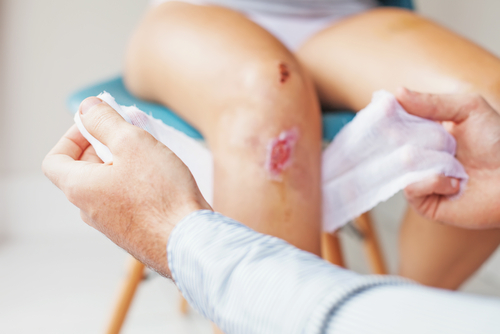Holistic Treatment Approach May Help Heal Long-Lasting SCD-Related Skin Ulcers, Case Report Shows
Written by |

A newly developed treatment approach, known by the acronym SICKLE, was shown to be a safe strategy to manage and treat long-lasting sickle cell disease-related ulcers in a case report.
This holistic approach was able to heal skin wounds, which had not responded to prior standard treatments, within six months.
The therapeutic potential of SICKLE was described in a study, “SICKLE as a holistic treatment approach to sickle cell disease related ulcers,” which was published in the British Journal of Nursing.
Sickle cell disease (SCD) is a genetic disorder that usually first manifests during childhood and is characterized by anemia (lack of healthy red blood cells), repeated infections, and episodes of pain.
One of the chronic complications that can result from SCD is leg ulcers, which tend to be particularly difficult to treat. Leg ulcers heal very slowly and can severely affect a patient’s quality of life.
Standard treatments for skin wounds from SCD consist of topical dressings and administration of oral or intravenous medications. However, these strategies are often unable to promote full recovery of the skin, so a new holistic strategy called SICKLE was developed to overcome these limitations.
SICKLE stands for “Skin assessment and management, Infection control, Compression, Keep moving keep debriding, Local strapping and shaping, and Endless support.”
The case study describes a woman, 24, with SCD, who was treated with the SICKLE protocol. She had a skin wound on her left ankle for four years, which had not healed with standard therapies.
The wound was 4×2 cm (about 1.6×0.8 inches) in size, and the patient experienced significantly reduced range of motion in the affected ankle. She had an infection at the wound site, which was surrounded by dry and scaly tissue.
During the first part of the SICKLE protocol, her skin was thoroughly examined, and was found to be fibrotic (with signs of scarring), which is a common problem in long-lasting skin ulcers.
The clinical team then focused on controlling the local infection on the wound. Treating the infection helps to ensure the restoration of a healthy wound bed and to manage the active inflammatory process so the skin can safely and more quickly heal.
The next step involved using bandages to compress the wound area and prevent tissue swelling, as edema (fluid accumulation in tissues) can prevent the wound from repairing properly.
Given that she was experiencing reduced ankle movement, the patient was seen by a podiatrist who recommended a series of movement exercises to promote and support skin wound recovery.
By the time of the first dressing change, the patient already showed some improvements. Still, the clinical team initiated sharp wound debridement, removing all biological material on the surface of the wound, such as dead tissue, that may promote infection and impede healing.
The next step was to apply cohesive short-stretch straps over the existing bandage to contour the ankle. This, along with applying local padding that was shaped according to the patient’s leg anatomy, helped to heal the wound in a short amount of time.
After four months, and following the SICKLE protocol, the woman’s wound had healed, and she switched to wearing compression socks for long-term management.
“Leg ulcers are one of the most important and debilitating problem in [SCD] patients,” the researchers wrote. “The SICKLE approach proved to be a safe and helpful therapeutic pathway to follow for improving quality of life and increasing healing rates.”
The SICKLE treatment protocol was applied to five other SCD patients with chronic wound ulcers, and it proved to safely promote skin recovery within six months.
Despite these positive clinical results, the team said that “more structured studies are needed to confirm the validity of this method.”





